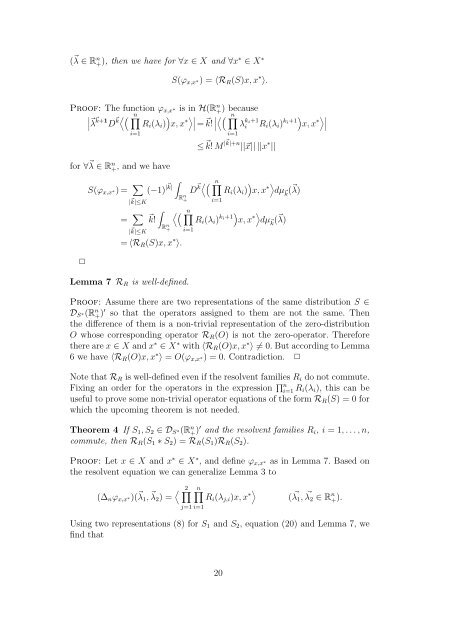The Stieltjes convolution and a functional calculus for non-negative ...
The Stieltjes convolution and a functional calculus for non-negative ...
The Stieltjes convolution and a functional calculus for non-negative ...
Create successful ePaper yourself
Turn your PDF publications into a flip-book with our unique Google optimized e-Paper software.
( ⃗ λ ∈ R n +), then we have <strong>for</strong> ∀x ∈ X <strong>and</strong> ∀x ∗ ∈ X ∗<br />
S(ϕ x,x ∗) = 〈R R (S)x,x ∗ 〉.<br />
Proof: <strong>The</strong> function ϕ x,x ∗ is in H(R n +) because<br />
∣ ⃗ λ ⃗k+1 D ⃗ 〈( ∏ n k<br />
R i (λ i ) ) x,x ∗〉∣ ∣〈( ∣ = ⃗ n k! ∣∣ ∏<br />
λ k i+1<br />
i R i (λ i ) ) k i+1<br />
x,x ∗〉∣ ∣ i=1<br />
<strong>for</strong> ∀ ⃗ λ ∈ R n +, <strong>and</strong> we have<br />
✷<br />
S(ϕ x,x ∗) = ∑<br />
| ⃗ k|≤K<br />
= ∑<br />
| ⃗ k|≤K<br />
∫<br />
(−1) |⃗ k|<br />
⃗ k!<br />
∫<br />
R n +<br />
= 〈R R (S)x,x ∗ 〉.<br />
R n +<br />
Lemma 7 R R is well-defined.<br />
i=1<br />
≤ ⃗ k!M |⃗ k|+n ||⃗x|| ||x ∗ ||<br />
D ⃗ 〈( ∏ n k<br />
R i (λ i ) ) x,x ∗〉 dµ ⃗k ( ⃗ λ)<br />
i=1<br />
〈( ∏ n R i (λ i ) ) k i+1<br />
x,x ∗〉 dµ ⃗k ( ⃗ λ)<br />
i=1<br />
Proof: Assume there are two representations of the same distribution S ∈<br />
D S ∗(R n +) ′ so that the operators assigned to them are not the same. <strong>The</strong>n<br />
the difference of them is a <strong>non</strong>-trivial representation of the zero-distribution<br />
O whose corresponding operator R R (O) is not the zero-operator. <strong>The</strong>re<strong>for</strong>e<br />
there are x ∈ X <strong>and</strong> x ∗ ∈ X ∗ with 〈R R (O)x,x ∗ 〉 ≠ 0. But according to Lemma<br />
6 we have 〈R R (O)x,x ∗ 〉 = O(ϕ x,x ∗) = 0. Contradiction. ✷<br />
Note that R R is well-defined even if the resolvent families R i do not commute.<br />
Fixing an order <strong>for</strong> the operators in the expression ∏ n<br />
i=1 R i (λ i ), this can be<br />
useful to prove some <strong>non</strong>-trivial operator equations of the <strong>for</strong>m R R (S) = 0 <strong>for</strong><br />
which the upcoming theorem is not needed.<br />
<strong>The</strong>orem 4 If S 1 ,S 2 ∈ D S ∗(R n +) ′ <strong>and</strong> the resolvent families R i , i = 1,...,n,<br />
commute, then R R (S 1 ∗ S 2 ) = R R (S 1 )R R (S 2 ).<br />
Proof: Let x ∈ X <strong>and</strong> x ∗ ∈ X ∗ , <strong>and</strong> define ϕ x,x ∗ as in Lemma 7. Based on<br />
the resolvent equation we can generalize Lemma 3 to<br />
(∆ n ϕ x,x ∗)( ⃗ λ 1 , ⃗ λ 2 ) = 〈 2∏ n∏<br />
R i (λ j,i )x,x ∗〉 ( λ ⃗ 1 , λ ⃗ 2 ∈ R n +).<br />
j=1 i=1<br />
Using two representations (8) <strong>for</strong> S 1 <strong>and</strong> S 2 , equation (20) <strong>and</strong> Lemma 7, we<br />
find that<br />
20



